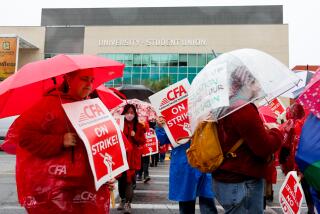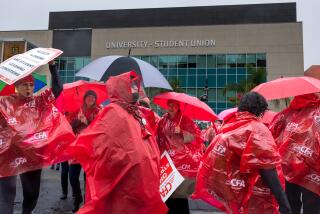Cal State Fullerton Remembers--Like Those 14 Elephants
The 2,000-pound tortoise racing 14 elephants down a dirt road near what now is Cal State Fullerton was Ernest Becker’s favorite memory.
For Justin Gray, it was working with the rest of the faculty on the second floor of a condemned building at Sunny Hills High School, which is now Fullerton High School. That, Gray explained, was the college’s entire campus during its early years.
“We became like a family there,” Gray said with a chuckle. “Because we all had to work out of the same damn room in the same damn building.”
These were just some of the memories rekindled last week when a sundial and plaque were dedicated at Cal State Fullerton’s main quad in honor of the 25 full-time faculty and staff members who opened the university 29 years ago. More than 70 former and current professors joined alumni and students for the dedication Wednesday.
University President Jewel Plummer Cobb said the sundial is “an expression of how the university is now a permanent part of this land.”
When the university opened in 1959, it was called Orange County State College and had an enrollment of 452, university officials said. Today, with more than 24,500 students, Cal State Fullerton is the largest four-year university in Orange County.
“I remember back when it was just 260 acres of orange groves,” said Becker, the first dean of students.
When the administration office opened at a nearby high school, he said, “The Fire Department told us we needed a fire escape from the
second floor. So, we tied a coil of rope from the president’s desk and hung it out the window--and that was our fire escape.”
The university first received national acclaim when the faculty and staff sponsored the first-ever collegiate elephant races, Becker said.
“It was all just a joke,” he recalled, one that began when administrators, demonstrating how campus clubs should fill out forms to register with the university, entered the title, “Elephant Racing Club.”
Soon people began to say, “ ‘Hey, why not?’ ” Becker said. “We didn’t think anyone was going to show up.”
More than 10,000 spectators and 83 reporters and photographers did show up, however, to watch professors and students from universities including Oxford, Cambridge and Harvard race elephants.
“The outcome was that it raised a lot of dust and a lot of fun,” he said. Harvard went home with the trophy.
Many of the former deans and professors attending the dedication said they were pleased with the university’s success, but feared the campus had become too impersonal.
“Students used to meet at my house for friendly little gatherings,” said William Maxwell, a professor of communications from 1960 to 1982. “We would chat and have a lot of fun.”
There was a “feeling of closeness between the professors and the students” that is difficult to re-create now in classes with 200 students, he said.
Yet some things never change, said Gray, who was the first dean of the School of Arts at the university and taught music from 1961 to 1982.
“In class, I could always spot that one bored kid sitting in the back of the room thinking about his date that night,” Gray remembered with a smile. “I’d always pick him and ask him the hardest question.”
More to Read
Sign up for Essential California
The most important California stories and recommendations in your inbox every morning.
You may occasionally receive promotional content from the Los Angeles Times.











